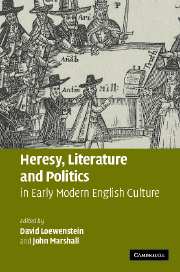Book contents
- Frontmatter
- Contents
- Acknowledgments
- Notes on contributors
- Introduction
- 1 Writing and the persecution of heretics in Henry VIII's England: The Examinations of Anne Askew
- 2 Anabaptism and anti-Anabaptism in the early English Reformation: defining Protestant heresy and orthodoxy during the reign of Edward VI
- 3 “Godlie matrons” and “loose-bodied dames”: heresy and gender in the Family of Love
- 4 Puritanism, Familism, and heresy in early Stuart England: the case of John Etherington revisited
- 5 A ticklish business: defining heresy and orthodoxy in the Puritan revolution
- 6 Thomas Edwards's Gangraena and heresiological traditions
- 7 “And if God was one of us”: Paul Best, John Biddle, and anti-Trinitarian heresy in seventeenth-century England
- 8 The road to George Hill: the heretical dynamic of Winstanley's early prose
- 9 Milton and the heretical priesthood of Christ
- 10 An Historical Narration Concerning Heresie: Thomas Hobbes, Thomas Barlow, and the Restoration debate over “heresy”
- 11 Defining and redefining heresy up to Locke's Letters Concerning Toleration
- 12 “Take heed of being too forward in imposinge on others”: orthodoxy and heresy in the Baxterian tradition
- Index
11 - Defining and redefining heresy up to Locke's Letters Concerning Toleration
Published online by Cambridge University Press: 20 February 2010
- Frontmatter
- Contents
- Acknowledgments
- Notes on contributors
- Introduction
- 1 Writing and the persecution of heretics in Henry VIII's England: The Examinations of Anne Askew
- 2 Anabaptism and anti-Anabaptism in the early English Reformation: defining Protestant heresy and orthodoxy during the reign of Edward VI
- 3 “Godlie matrons” and “loose-bodied dames”: heresy and gender in the Family of Love
- 4 Puritanism, Familism, and heresy in early Stuart England: the case of John Etherington revisited
- 5 A ticklish business: defining heresy and orthodoxy in the Puritan revolution
- 6 Thomas Edwards's Gangraena and heresiological traditions
- 7 “And if God was one of us”: Paul Best, John Biddle, and anti-Trinitarian heresy in seventeenth-century England
- 8 The road to George Hill: the heretical dynamic of Winstanley's early prose
- 9 Milton and the heretical priesthood of Christ
- 10 An Historical Narration Concerning Heresie: Thomas Hobbes, Thomas Barlow, and the Restoration debate over “heresy”
- 11 Defining and redefining heresy up to Locke's Letters Concerning Toleration
- 12 “Take heed of being too forward in imposinge on others”: orthodoxy and heresy in the Baxterian tradition
- Index
Summary
When John Locke composed his Letter Concerning Toleration in exile in the Netherlands in 1685 and his Second and Third Letters after his 1689 return to England he faced arguments for religious intolerance which, as he knew, had been particularly powerful in Christianity since the fourth century and which were dominant arguments in sixteenth- and seventeenth-century Europe among Protestants as well as Catholics. In this essay I will trace some of these arguments for intolerance and their prevalence in early modern Europe, focusing especially on England and especially on the continuing power in early modern England of inherited identifications of heretics as diseased and poisoning murderers, seditious communists, “libertines,” and “sodomites.” I will then analyze Locke's redefinitions of heresy and some of his arguments for religious toleration, showing how he redefined heresy in order to support religious toleration and how he denied that this involved support of the spreading of poison and disease, sedition, communism, “libertinism,” and “sodomy.”
Early modern Europeans inherited identifications of “heresy” and characterizations of “heretics” from a host of frequently republished patristic and medieval works. That these works commanded continued authority in defining and anathematizing “heresy” was due both to deep reverence for the Fathers, and to the belief that contemporary “heretical” challenges to “orthodoxy” were rehearsals of preceding “heresies.” According to early modern “orthodox” Catholics and Protestants, contemporary “heretics” such as Anabaptists, anti-Trinitarians, Familists, Arminians, and Quakers were repeating medieval and patristic “heresies” such as Catharism, Manicheanism, Arianism, Gnosticism, and Pelagianism.
- Type
- Chapter
- Information
- Heresy, Literature and Politics in Early Modern English Culture , pp. 254 - 281Publisher: Cambridge University PressPrint publication year: 2006
- 2
- Cited by



